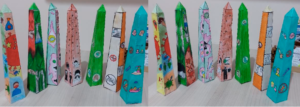News . Best Practices Obelisk of COVID-19 (Best Practice Brazil)

This open scenario practice was carried out during the pandemic by Professor Sueli Perazzoli Trindade in the discipline of Art, on the theme “Obelisk of COVID-19”, at the School of Basic Education Professor Adelina Régis. Students interacted with social scientists, educational researchers, and the local community, including family members. It was supported by APC PUC-PR
CARE: The students were involved in the discussion about the COVID-19 contingency plan. The participants were 95 students, between 14 and 16 years old, from the 1st grade of high school, of which 76 completed the scientific actions, along with their families, a teacher, a researcher and a scientist who shared their concerns about COVID-19 and ideas about as the artistic making, especially the construction of obelisks, has its historical and cultural role, in this case, as pictograms representing the care against the contamination of COVID-19, they could compose an obelisk emphasizing the historical and artistic context of the pandemic.
KNOW: Curricular knowledge was worked, in an interdisciplinary and transdisciplinary way, emphasizing the analysis of historical and scientific data in the disciplines of Art and Science. This made it possible, in a practical way, for students to interact and play a leading role in the learning process: the analysis of cultural heritage in the historical context of humanity; the identification of pictograms in visual communication contextualized with the colors of the traffic light and with Covid-19; exhibition of the study carried out in open spaces at the school and presentation of the artistic productions of the obelisks emphasizing the awareness of the theme addressed were the learning opportunities offered to the students. Quality of life, health, prevention, language and communication, artistic creation, pictograms, colors, cultural heritage of humanity in relation to COVID-29 were the bases of learning.
The ability to relate knowledge with pictograms, to establish relationships between communication, art, and knowledge, were developed through individual and collective practices contemplating the analysis and experiences that addressed the artistic and cultural heritage monuments contextualized with COVID-19. The skills to make responsible decisions to ensure the quality of life in times of a pandemic, as well as the value of human life in/in the world, were also development focuses. As attitudes, it was sought to protect human life; to identify measures to prevent and control the contamination of the coronavirus, to redefine the school curriculum with theories and practices in times of COVID-19, to value the knowledge built in the school environment for life in society and to promote reflections with research at school, family and community about the pandemic in real time.
DO: Students were involved in the following activities:
- Analyze Obelisks from Egypt and Brazil, regarding their contributions to the history of humanity and the meaning of the images in the historical, political, social, and cultural context.
- Contextualize the importance of the “Obelisk” monument in the record of historical facts on the timeline in different spaces.
- Searching bibliographic sources in real time about COVID-19.
- Reading of the material available on the prevention and vulnerability of the cities of Santa Catarina, in the pandemic, including the city where the school is located.
- Understand and interpret the language and communication of pictograms in the context of society as language and communication contextualized with COVID-19.
- Elaboration and exhibition of the “Obelisk of COVID-19” with pictograms of prevention against coronavirus.
FINDINGS: The open scenario methodology used was project-based collaborative learning. Students brought their own questions, discussed with the scientists and their families. They learned the artistic language in a contextualized and meaningful way. Teachers found the open teaching activity useful for contextualizing COVID-19 from the perspective of its artistic-cultural and historical representation. The adaptations took place in accordance with the theories and learning practices of the New High School. In general, it fits perfectly into the school curriculum by exploring and complementing actions already developed and based on competences and skills in teaching by areas of knowledge. This facilitated the planning of actions and the applicability of learning activities. Teachers meet weekly and seek theories and practices compatible with the subject addressed, technological resources that expand the possibilities of access to science.
OUTCOMES: The participation of students was significant in carrying out the activities. It was evident that the dialogue between the areas of knowledge was relevant for the engagement, interaction, and production of scientific knowledge. Students felt protagonists in the learning processes. There have been changes in attitudes and habits in relation to care in the prevention of COVID-19 in school, family, and society spaces. It is not always possible to achieve the participation of all, however, it is observed that the number of students who were not included in the learning process is minimal.
The expectations of the students surprised each class, as they eagerly awaited something different to learn about the historical and cultural monuments; the pictograms; the colors most present in the daily lives of people in/of society which are: green, yellow, and red that indicate responsible actions to be taken in traffic and prevention against COVID-19. It was wonderful, the moment that the students were able to make the relationship between Art and Science in real time. The loom in the learning process made it possible to reframe the school curriculum in dialogue with everyday knowledge of students and family members to adapt to the new social and cultural context in times of COVID-19. There was the scientific perception that we are united and interconnected with the universe we live in and subject to changes for the quality of life.
Find out more here: Our report.